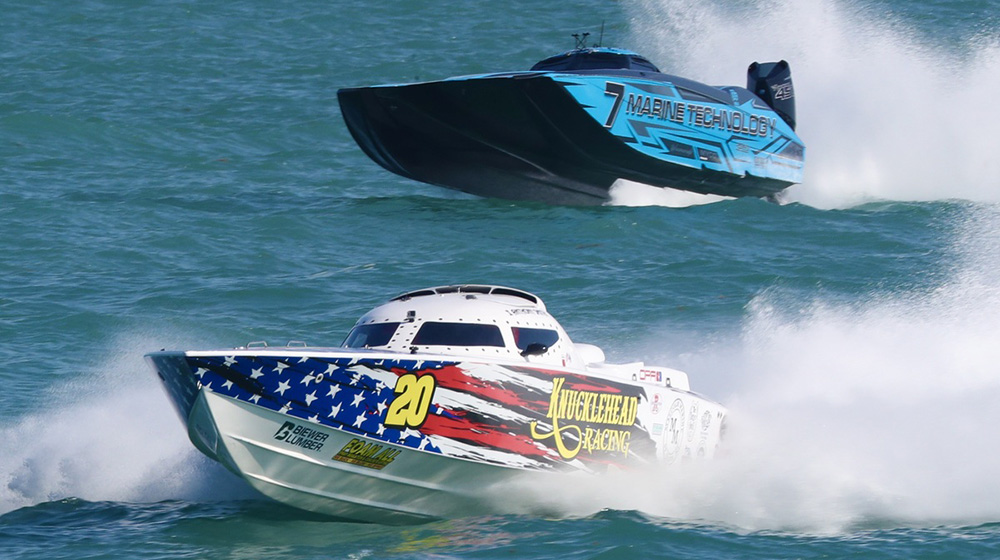So you want to be a powerboat racer? A good first step to an exciting career in powerboat racing is making sure you’re well-prepared. There are many decisions to make and steps to take, but with the essential information, you can determine if you’re ready or not.
Learning the Basics
You have to learn about the mechanics and design of powerboats if you want to race them successfully. This will allow you to understand the features and specifications that increase speed without compromising safety, so you can buy the boat that’s right for you and/or make modifications accordingly.
For example, the hull design, propellors, and engine of your boat all affect the top speeds your boat is capable of reaching. How many blades should your propellor contain? What’s the ideal thickness of the propellor blades for your boat? Which engine model should you choose for your boat and your price point? How much power is too much or too little for your boat? These are just a few aspects of powerboat design and mechanics that you should be familiar with.
Keep in mind that powerboats come in all forms, shapes, and sizes. The type of boat you choose will determine which races and categories you can participate in. V-shaped hulls (V-bottom) are the most common design for powerboats, but catamaran racing is also popular. Other options include open vs. closed cockpits, and outboard vs. inboard motors.
The Costs
A major point to consider is your budget. Owning any boat comes with big expenses, which you’re probably already aware of, but racing incurs many other costs beyond basic boat ownership. For instance, if you want to make a go of racing, you’ll need a budget to pay for spare parts, modifications, a tow rig, travel costs, race entry fees, and a crew. Fuel costs can also be substantial, of course.
The Safety Gear
As with any sport, wearing the proper gear is crucial to safety, comfort, and performance. When considering powerboat racing, a helmet, neck restraint, life jacket, driving suit, gloves, and shoes are important items to have.
In American Power Boat Association (APBA) races, racers must wear helmets that meet the specifications required to race, including colors that are vibrant and easy to see. A neck restraint isn’t always a requirement. However, due to the high level of stress your body can experience during racing, many racers choose to use one. An APBA-compliance life jacket must be as bright as the racer’s helmet. Any driving suit generally needs to be fire-retardant and must be worn over protective clothing.
Gloves help grip the wheel better while driving, so almost every boat racer wears them. Closed-toe shoes and cut-resistant socks are normal wear for racers as well.
Driving School
If you’re interested in powerboat racing, you probably already know how to drive a boat—most people become interested in racing after taking up boating for fun. However, racing is a different beast altogether. It may be tempting to ask a friend to teach you the ins and outs of powerboat racing, but the best and safest way to learn is through a professional boat racing environment. Trained racers make great teachers, but they should be certified to instruct. In a controlled racing environment, you will learn the proper techniques of lining up, turning, and the most important information to keep yourself safe while achieving high speeds.
Attending Races
Check with your local marina or powerboat club to learn about races in your area. The APBA also publishes a schedule of races online, as does the Offshore Powerboat Association (OPA).
Races are tons of fun to watch—plus, going to races will allow you to see how the courses are structured and learn more about the boats the racers are driving. Attending races will also give you the opportunity to meet professional racers, not to mention other fans, and ask them questions.
The Categories
Inshore powerboat racing and offshore powerboat racing are two major categories of powerboat racing. Inshore powerboat racing competitions can take place on bays, lakes, and rivers, while offshore powerboat races are held on the ocean. Within each type of race, there are other categories, and they all depend on the type of boat you are racing. Below is a list of other racing categories you may encounter:
Inboard
Inboard Endurance
Offshore
Professional Outboard
Modified Outboard
Stock Outboard
Outboard Performance Craft
Outboard Drag
Unlimited
Thundercat
Junior Classes
R/C Model
Personal Watercraft
Special Event
Racing Memberships
Joining an association like the APBA, OPA, or Super Boat International allows you to participate in races organized by these groups. Of course, your local marina or boating club may also organize races that aren’t sanctioned by the major boating associations. These are an option, too—and in fact, it’s best to enter smaller local races first, just to see if you truly enjoy powerboat racing, or just the idea of it. Even if you don’t do well, don’t worry about it. Consider it a learning experience and the first step in your racing journey.

